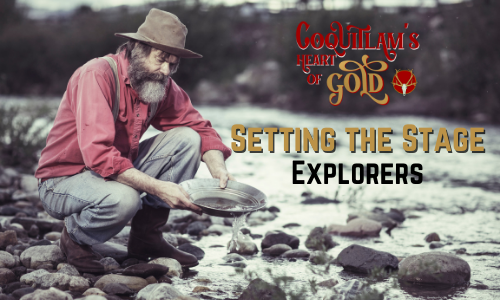Explorers
1858 Fraser River Gold Rush, the 1862 Cariboo Gold Rush, and the Klondike Gold Rush of 1899, drew thousands of people to British Columbia for adventure and profit, whether it was to search for gold, build roads, or set up shop as an innkeeper or merchant. When the gold rushes ended, many of these seekers remained in the province and helped to create communities like the Coquitlam we know today.
Before we begin, we would like to acknowledge the unceded territories of the First Peoples of British Columbia, on whose land we live, work, play, and on whose land we mined for gold. The Cariboo Gold Rush (1859) took place in the interior of what is colonially known as the Cariboo region, on the traditional and unceded territories of the Nlaka’pamux, the St’atl’imx, the Secwepemc, The Tsilqot’in, and the Dakelhne peoples.
British Columbia was one of the last places on Earth to be explored by Europeans. It was difficult to get to; one would have to travel across a vast continent and over the Rockies to get there or take a ship down and around the notoriously dangerous Cape Horn at the bottom of what is now Chile. The first explorers to make it here took the latter route. They arrived to find an abundantly rich land full of natural resources that had been continuously occupied for well over ten thousand years and claimed it for their own sovereign nations. The first documented Spanish visitor was Juan Francisco de la Bodega y Quadra (1743-1794) who visited the Pacific Northwest Coast in 1775, though he and his crew did not make any stops in what is now British Columbia. The first British explorer was Captain James Cook (1728-1779) in 1778. He traded with the Nuu-chah-nulth and after that trade with the First Peoples of British Columbia became a regular occurrence.
MAP OF THE DISCOVERIES MADE BY CAPTS. COOK AND CLERKE IN THE YEARS 1778 AND 1779 BETWEEN THE EASTERN COAST OF ASIA AND THE WESTERN COAST OF NORTH AMERICA, WHEN THEY ATTEMPTED TO NAVIGATE THE NORTH
Overland, the notable explorers include Alexander Mackenzie (1764-1820), who was the first European to cross North America north of Mexico, and Simon Fraser (1776-1862), who charted much of British Columbia and also established the first European settlement in BC. Along the way forts were established and trade routes were cemented. The fur trade was a roaring business, and the lumber industry was soon to take off. The discovery of gold was only a matter of time.
Of course, the existence of gold in the area had likely been known for millennia. The First Peoples of the Pacific Northwest were skilled metallurgists. There is not much evidence that they made objects out of gold, preferring copper for status items, presumably due to its hardness and versatility, as well as its aesthetic qualities. It could be that they did not value gold as they did copper.
HAIDA COPPER, SEATTLE ART MUSEUM
They quickly learned that colonizers of what they called Caledonia, and later British Columbia, valued the yellow rocks very much. In 1851 an 840 gram gold nugget from what is now Haida Gwaii was traded by a Haida man in Fort Victoria for 1500 blankets and the Queen Charlottes Gold Rush began. The 1896 Klondike Gold Rush kicked off after Shaaw Tláa (Kate Carmack), a Tlingit woman, found gold in the Klondike River. As news spread about the wealth that could be found, people from all over began flooding in, shaping and forever changing British Columbia’s landscape and people.



